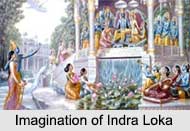 Indra loka is also known by names like "Swarga" and "Amravati". Indra Loka was built by Lord Vishwakarma, the architect of the Gods, son of Lord Brahma. The inhabitants of Indra Loka are entertained by music, dancing, and every sort of celebration. It is believed that the audience chamber of Indra Loka is so large that it accommodates all the three hundred and thirty millions of celestials, together with the forty-eight thousand Rishis and the multitude of attendants.
Indra loka is also known by names like "Swarga" and "Amravati". Indra Loka was built by Lord Vishwakarma, the architect of the Gods, son of Lord Brahma. The inhabitants of Indra Loka are entertained by music, dancing, and every sort of celebration. It is believed that the audience chamber of Indra Loka is so large that it accommodates all the three hundred and thirty millions of celestials, together with the forty-eight thousand Rishis and the multitude of attendants.
Myths of Indra Loka
As per Hindu mythology, there are seven higher worlds and seven lower ones. The higher worlds are the Seven Spheres "vyahrtis" or "lokas", namely "bhuvar", "deva", "mahar", "jana", "Indra", "rudra" and "marut" and the lower ones (the "seven underworlds" or paatala lokas) are "atala", "vitala", "sutala", "rasaataala", "talatala", "mahaatala", "paatala". The heaven of Lord Indra is described having heavenly gardens planted with luxuriant trees, which have delicious fruits. The fragrant groves are preoccupied by fairy nymphs.
It is said that the low, sweet music is heard in Indra Loka. It is believed that Indra`s abode is eight hundred miles in circumference and forty miles in height. The pillars are made of diamonds and the palaces are made of pure gold. Rich perfume of the rose-colored flowers is laden rich in the air. The heaven of Lord Indra is an area for the good alone with heavenly gardens called "Nandana" planted with holy trees and sweet-scented flowers. The fragrant groves are occupied by the "Apsaras".
This article is a stub. You can enrich by adding more information to it. Send your Write Up to content@indianetzone.com.




















